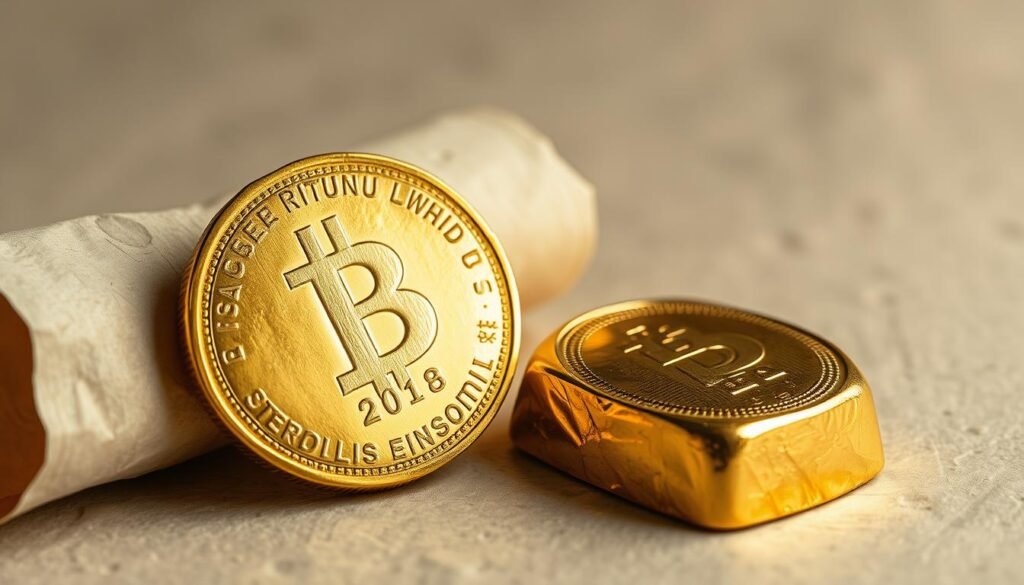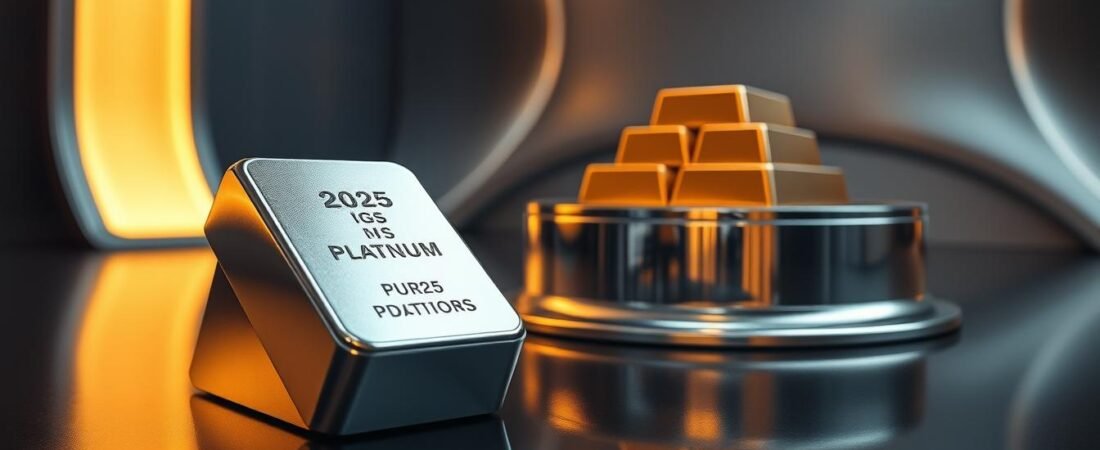Gold prices have surged to a record $3,500 per ounce this year. That’s a powerful 30% jump. Silver isn’t far behind, climbing 31%. This explosive growth signals a major shift in the global financial landscape.
Economic uncertainty and geopolitical tensions are driving this historic moment. Your portfolio faces real challenges from inflation and market swings. These assets offer a time-tested shield against such volatility.
Major institutions like J.P. Morgan project this trend will continue. They forecast even higher averages for the coming quarters. Central banks are also accumulating these holdings at a remarkable pace.
This analysis provides critical insights for the current year. You will see how traditional safe-haven appeal combines with new industrial demand. It’s a unique opportunity for savvy investors to build a resilient strategy.
Key Takeaways
- Gold and silver have achieved significant price gains, signaling strong market momentum.
- Economic and geopolitical factors are creating a powerful demand for tangible assets.
- Expert forecasts from leading institutions point toward continued upward price trends.
- These holdings can help protect your wealth against inflation and market instability.
- Both institutional and individual investors are increasing their allocations.
- Understanding the current drivers is essential for making informed portfolio decisions.
Understanding the Market Landscape
Navigating the financial landscape requires a clear understanding of the complex forces shaping the market. Several key factors are driving current conditions and influencing asset values.
Global Economic and Geopolitical Uncertainty
You face a market characterized by unprecedented levels of economic uncertainty. Shifting trade policies and unpredictable geopolitical alliances make traditional risk assessment difficult.
This environment prompts a search for assets with historically low correlation to equities and bonds. Gold plays its traditional protective role here. Its safe-haven status provides insurance during times of stress.
Market data shows this clearly. In April, gold prices reached a peak, demonstrating how investors value its stability when economic visibility diminishes.
Inflation and Currency Risks
Your exposure to inflation and currency risks has intensified. Central banks worldwide struggle to balance controlling price increases with supporting growth.
This creates ongoing pressure on fiat currency purchasing power. Gold serves as a powerful debasement hedge against this erosion of value.
Currency risks now extend beyond simple dollar weakness. A broader reconfiguration of reserve holdings is underway. In this climate, these assets offer dual protection from geopolitical shocks and appreciation potential.
Key Trends Impacting Precious Metals in 2025
Current market dynamics reveal a dramatic transformation in how participants approach asset allocation. Traditional portfolio models face challenges from persistent inflation and geopolitical tensions.
Shifting Investor Sentiment
You are witnessing a fundamental change in how market participants view tangible assets. Both institutional and individual investors recognize that conventional diversification may not provide adequate protection.
This sentiment shift reflects growing concerns about simultaneous equity and bond market pressures. Gold and other tangible assets offer insurance characteristics that become valuable during such periods.
ETFs and Physical Holdings Growth
The expansion of exchange-traded funds represents a significant development. Recent data shows substantial inflows into ETFs, with Chinese exchange-traded funds experiencing remarkable 70% growth.
Total global holdings have reached approximately 49,400 tonnes. Private ownership of bars and coins dominates this landscape, showing continued preference for physical assets.
The notional value of these positions surged to $5 trillion by Q1 2025. This growth demonstrates sustained conviction among diverse market participants.
why invest in precious metals 2025: Expert Insights and Forecasts
Market projections from top analysts reveal significant opportunities in the coming months. Leading financial institutions provide valuable insights that shape strategic decisions.
Price Forecasts and Projections
J.P. Morgan Research expects gold to average $3,675 per ounce by Q4 2025. The projection shows movement toward $4,000 by mid-2026.
This bullish outlook reflects sustained demand data. Quarterly demand averages 710 tonnes from combined sources.

Silver also shows strong potential. Analysts project prices reaching $40-$50 per ounce. This represents potential 17% gains by Q3.
“Risks are skewed toward an earlier overshoot of forecasts if demand continues surprising to the upside.”
Institutional and Central Bank Activity
Central banks are forecasted to purchase 900 tonnes this year. This follows three consecutive years of 1,000+ tonne buying.
Global central banks now hold nearly 36,200 tonnes. This represents almost 20% of official reserves.
| Country | 2024 Purchases | Strategic Focus |
|---|---|---|
| Poland | 20+ tonnes | Reserve diversification |
| Turkey | 20+ tonnes | Currency stability |
| India | 20+ tonnes | Portfolio balance |
| China | 20+ tonnes | Strategic accumulation |
This data validates the strategic positioning of sophisticated institutional investors. Your approach aligns with global monetary authorities.
Comparing Gold and Silver: Diversification in Your Portfolio
Gold and silver, while often grouped together, serve different strategic purposes for your portfolio. Understanding these distinctions is key to effective diversification.
Each metal offers a unique blend of risk and return characteristics. A balanced approach can enhance your overall asset allocation strategy.
Gold’s Role as a Safe Haven
Gold maintains its primary role as a defensive asset. Its 28% gains this period underscore its status as a reliable store value.
This performance is driven by geopolitical tensions and market volatility. It acts as insurance for your portfolio during uncertain times.

Silver’s Industrial Demand and Growth Potential
Silver possesses a powerful dual nature. Beyond its investment appeal, strong industrial demand provides a solid foundation for growth.
Sectors like solar energy and electric vehicles consume significant amounts. This creates a constant pull on the available supply.
“The convergence of monetary and industrial drivers makes silver a uniquely positioned commodity.”
Balancing Risk and Return
Your portfolio balance requires acknowledging silver’s higher volatility. Its smaller market can lead to larger price swings.
For instance, prices fell from $35.29 to $19.08 between 2011 and 2014. This highlights the need for careful position sizing.
| Attribute | Gold | Silver |
|---|---|---|
| Primary Driver | Monetary Safe-Haven | Industrial & Investment |
| Market Volatility | Lower | Higher |
| Entry Point (approx.) | $3,300+/oz | $38/oz |
| Storage Cost Impact | Lower (% of value) | Higher (% of value) |
This comparison helps you build a more resilient precious metals allocation. It optimizes your strategy for both protection and potential appreciation.
Strategies for Building a Precious Metals Portfolio
Constructing a resilient portfolio requires strategic allocation across different asset classes. You must balance convenience against direct ownership when selecting your approach.
Investing in Gold and Silver ETFs
Exchange-traded funds provide immediate market exposure with daily liquidity. These investment vehicles have seen 310 tonnes of inflows year-to-date.
This represents 10% growth in total global holdings. Chinese ETF holdings surged 70%, showing strong capital markets interest.
You can gain exposure through established solutions like iShares Physical Silver. These funds hold physical metal in allocated storage.
Direct Physical Purchases
Acquiring coins, bars, or bullion offers tangible asset ownership without counterparty risk. Reputable sources like government mints provide various size options.
Trusted providers offer institutional-grade storage solutions for your holdings. Storage costs typically start around 0.55% annually.
Consider revaluation fees when selling partial positions. These practical factors impact your net returns.
Mining stocks represent another option for gaining exposure. They offer leveraged price potential but introduce additional operational risks.
Your final strategy should recognize that each solution serves distinct purposes. Balance tactical positioning with long-term preservation goals.
Risk Management and Market Volatility
Effective risk management forms the foundation of any successful investment strategy involving commodities. Your approach must account for the unique characteristics of these markets.
Understanding price behavior helps you navigate different market conditions. Each commodity presents distinct challenges and opportunities.
Understanding Volatility in Commodity Markets
Commodity markets experience significant price swings. Gold typically shows lower volatility than silver due to market size differences.
Silver’s smaller market can exaggerate price movements. The 2011-2014 period saw prices drop 46%, testing investor conviction.
Hedging Against Inflation and Currency Fluctuations
These assets serve as powerful protection against currency debasement. They hedge against the unique combination of stagflation and policy risks.
J.P. Morgan Research views this approach as optimal for current conditions. Your hedge strategy should address multiple risk factors simultaneously.
Diversification Across Investment Types
Diversification within your allocation manages different volatility profiles. Balance ETFs, physical holdings, and mining equities for optimal risk management.
Each investment type offers distinct advantages. Your portfolio benefits from this multi-faceted approach to commodity exposure.
Conclusion
Diversification across asset classes with different risk profiles remains essential for long-term wealth preservation. The data presented demonstrates how strategic allocations can enhance portfolio resilience during periods of market uncertainty.
Institutional investors and central banks continue building significant holdings, validating this asset class as a core component of modern portfolio construction. This trend shows no signs of slowing in the coming years.
Your approach should balance the defensive characteristics of one metal with the growth potential of another. This strategic positioning allows you to navigate complex market conditions with confidence.

